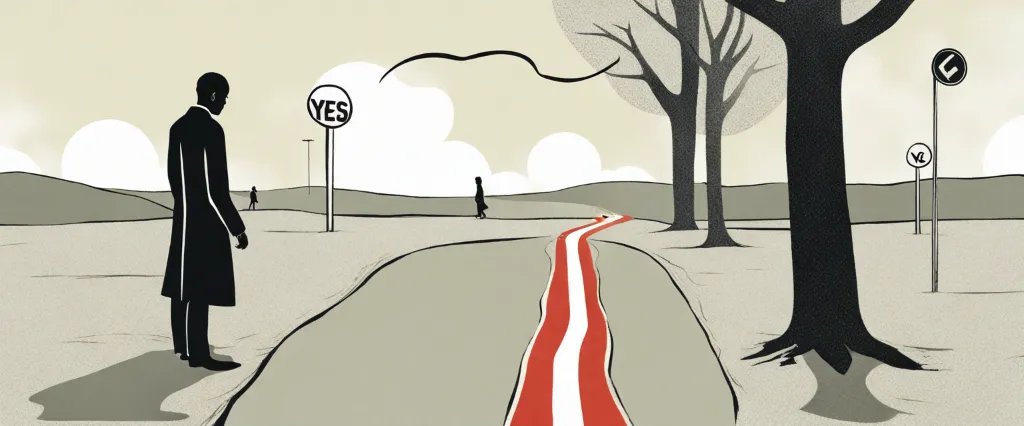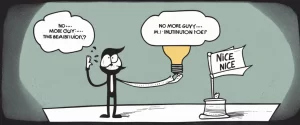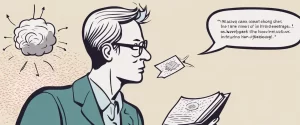——When I Say No I Feel Guilty by Manuel J. Smith & Your Erroneous Zones by Wayne Dyer

In the realm of personal growth and self-help literature, two prominent titles have emerged as timeless classics: “When I Say No I Feel Guilty” by Manuel J. Smith and “Your Erroneous Zones” by Wayne Dyer. Throughout the pages of these influential books, both authors tackle the intricacies of human behavior, underlying beliefs, and the art of asserting oneself. Although written in different eras, these works share a common objective: empowering individuals to break free from the confines of guilt, people-pleasing, and erroneous thinking patterns.
Published in 1975, “When I Say No I Feel Guilty” by Manuel J. Smith explores the complex dynamics of assertiveness and its impact on personal well-being. Smith, a psychologist and a renowned expert in the field, delves into the emotional landscape of guilt and its underlying causes. Through practical techniques and insightful anecdotes, he provides readers with a roadmap to reclaim their power and establish healthy boundaries in various aspects of life.
On the other hand, “Your Erroneous Zones” by Wayne Dyer, first published in 1976, takes a holistic approach to self-improvement, targeting the erroneous beliefs that hinder personal growth. As a prominent speaker and author, Dyer challenges individuals to question their limiting thoughts, offering a groundbreaking perspective on self-realization and the pursuit of happiness. In his book, he shares profound insights and strategies to identify and overcome self-sabotaging patterns, encouraging readers to liberate themselves from the shackles of societal expectations.
While these two books may differ in terms of approach and focus, they undeniably share a common thread: the importance of self-awareness and the ability to assert one’s needs and desires. Both Smith and Dyer seek to navigate the treacherous waters of guilt, fear, and faulty thinking patterns that hold individuals back from leading fulfilling lives. By examining these renowned works side by side, we can gain a deeper understanding of the fundamental principles, techniques, and philosophies present in the realm of self-help literature.
In this comparative study, we will explore the key themes, strategies, and underlying philosophies presented in “When I Say No I Feel Guilty” and “Your Erroneous Zones.” By examining their similarities and differences, we aim to provide a comprehensive analysis of the ideologies proposed by Smith and Dyer. Moreover, through this exploration, we will unlock valuable lessons and practical insights that can be applied to our own lives, ultimately empowering us to break free from self-imposed limitations and forge a path towards personal growth and fulfillment.
Brief Summary of Two Books
When I Say No I Feel Guilty by Manuel J. Smith
“When I Say No, I Feel Guilty” by Manuel J. Smith is a self-help book that explores the concept of assertiveness and provides practical strategies for effectively expressing oneself while maintaining healthy relationships. The book helps readers understand the roots of their own guilt-inducing behavior and offers step-by-step guidance on how to overcome it. Smith emphasizes the importance of owning one’s feelings and rights, teaching readers how to effectively communicate and assert their needs, desires, and boundaries. Through various techniques such as “broken record,” “fogging,” and “negative assertion,” the author empowers readers to handle common guilt-tripping tactics and manipulative behaviors. By learning to say no while feeling confident and guilt-free, readers can enhance their self-esteem, improve their interpersonal relationships, and create a more fulfilling and balanced life.
Your Erroneous Zones by Wayne Dyer
“Your Erroneous Zones” by Wayne Dyer is a self-help book that explores the concept of self-improvement and personal growth. The central premise of the book is that individuals have control over their thoughts, feelings, and actions, and can therefore overcome the limitations imposed by their erroneous beliefs and societal conditioning.
Dyer categorizes the erroneous zones into three main areas: the past, the present, and the future. He delves into the ways in which individuals often dwell on past mistakes and regrets, which can hinder personal development. He emphasizes the importance of forgiveness and letting go of past grievances to achieve inner peace.
In the present, Dyer discusses how individuals often seek external validation and approval, which can lead to unhappiness and a lack of self-worth. He encourages readers to develop self-acceptance and free themselves from the opinions of others.
Looking to the future, Dyer explains how individuals often limit themselves by having negative expectations and a fear of the unknown. He encourages readers to focus on the present moment and utilize their own potential to create a positive and fulfilling future.
Throughout the book, Dyer offers practical advice, exercises, and anecdotes to help readers challenge their erroneous beliefs and take responsibility for their own thoughts and actions. He encourages the pursuit of personal growth, self-awareness, and the cultivation of healthy relationships.
Overall, “Your Erroneous Zones” is a motivational and empowering guide that aims to help readers break free from self-limiting beliefs and societal pressures, allowing them to live authentically and embrace their true potential.
Comparison between Two Books

Similarities in self care
Both “When I Say No I Feel Guilty” by Manuel J. Smith and “Your Erroneous Zones” by Wayne Dyer discuss the importance of self-care as a means of establishing healthy boundaries and maximizing personal well-being.
1. Acknowledging one’s own needs: Both books emphasize the necessity of recognizing and valuing one’s own needs and desires. They advocate for individuals to prioritize their mental, emotional, and physical well-being by honestly assessing their own wants and needs.
2. Setting boundaries: Self-care involves establishing boundaries in various areas of life. Both authors emphasize the importance of setting limits on one’s time, energy, and emotional availability. By learning to say no when necessary and enforcing boundaries, individuals can avoid overextending themselves and maintain a healthy balance.
3. Assertiveness and self-expression: Both books emphasize the significance of assertiveness in self-care. They teach individuals to express their thoughts, emotions, and boundaries in a clear and respectful manner. Through assertiveness, individuals can openly communicate their needs and protect their well-being.
4. Guilt reduction: Both books address the issue of guilt that often accompanies self-care. They provide strategies for managing guilt by helping readers understand that self-care is not selfish but rather an essential part of overall well-being. Both authors encourage individuals to let go of unnecessary guilt and adopt a more compassionate and understanding approach towards themselves.
5. Responsibility for one’s own happiness: Both books stress the importance of individuals taking responsibility for their own happiness and well-being. They encourage readers to shift away from seeking external validation or relying on others for fulfillment. Instead, they advocate for self-care practices that enable individuals to develop self-reliance and self-empowerment.
6. Cultivating self-awareness: Both authors highlight the significance of self-awareness in self-care. They encourage readers to explore their inner thoughts, emotions, and belief systems. Through self-awareness, individuals can identify and address negative patterns, anxieties, and misconceptions, thus improving their self-care practices.
In conclusion, “When I Say No I Feel Guilty” and “Your Erroneous Zones” touch upon similar themes related to self-care. They both emphasize the importance of acknowledging one’s needs, setting boundaries, practicing assertiveness, reducing guilt, taking responsibility for personal well-being, and cultivating self-awareness. By implementing these principles, individuals can enhance their self-care practices and improve their overall quality of life.
Divergences in self care
“When I Say No I Feel Guilty” by Manuel J. Smith and “Your Erroneous Zones” by Wayne Dyer are two influential self-help books that address assertiveness and personal growth. While both books tackle similar topics and aim to empower readers, there are diverging perspectives on the concept of self-care.
In “When I Say No I Feel Guilty,” Smith focuses on the importance of assertiveness and communication skills for personal development. The book encourages individuals to value their own needs and desires, teaching them techniques to effectively express themselves and say no without feeling guilty. Smith emphasizes the idea that prioritizing oneself, setting personal boundaries, and learning to say no can ultimately lead to a healthier and more balanced life.
Contrastingly, in “Your Erroneous Zones,” Dyer presents a broader approach to self-improvement, focusing on a variety of topics such as negative thinking, emotional liberation, and personal happiness. Although Dyer introduces the concept of self-care, he takes a more spiritual and holistic perspective. Dyer asserts that true self-care involves understanding and aligning one’s thoughts, emotions, and actions with a higher universal consciousness. He emphasizes cultivating a positive mindset, practicing forgiveness, and developing a strong sense of self-worth in order to experience true fulfillment.
The divergence about self-care between these books lies in the specific approaches they advocate. “When I Say No I Feel Guilty” prioritizes self-care by emphasizing assertive communication and setting personal boundaries as essential components of self-care. Smith’s book encourages readers to prioritize their own needs and be unapologetic in saying no, promoting a more individualistic focus on self-care.
On the other hand, “Your Erroneous Zones” encompasses self-care as a holistic practice that incorporates mental, emotional, and spiritual well-being. Dyer’s book encourages readers to examine their beliefs and thoughts, develop a positive mindset, and seek spiritual connectedness in order to achieve genuine self-care.
In summary, “When I Say No I Feel Guilty” and “Your Erroneous Zones” both offer guidance on personal growth, empowerment, and assertiveness. However, “When I Say No I Feel Guilty” places more emphasis on assertive communication and personal boundaries as integral to self-care, while “Your Erroneous Zones” takes a broader approach, highlighting spiritual alignment and positive thinking as central to authentic self-care.

Conclusion
Both “When I Say No I Feel Guilty” by Manuel J. Smith and “Your Erroneous Zones” by Wayne Dyer offer valuable insights and self-help advice. Ultimately, the choice of which book is more worthy of reading depends on your personal preferences and specific needs.
“When I Say No I Feel Guilty” focuses on assertiveness training and helps individuals develop healthier communication and boundary-setting skills. It explores situations where people tend to feel guilty for saying no and provides techniques to overcome these feelings. This book is particularly helpful for those who often struggle with people-pleasing tendencies or find it challenging to assert themselves effectively.
On the other hand, “Your Erroneous Zones” by Wayne Dyer delves into various erroneous beliefs and patterns of thinking that hinder personal growth and happiness. Dyer provides practical strategies to identify and overcome these negative patterns, allowing readers to live more fulfilling lives. This book is beneficial for anyone seeking self-improvement, personal development, and a greater understanding of themselves.
Both books offer valuable insights and guidance, and it may be worth considering your specific needs and interests to select the book that resonates with you more. Reading reviews and summaries of these books may also help you make an informed decision.



